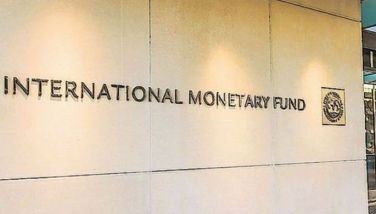Startling facts about ethanol
August 3, 2004 | 12:00am
A lot of people have questioned me about my advocacy of ethanol, either as a fuel mixed with gasoline or used by itself. That’s no pipe dream. The Philippine Sugar Alliance recently came up with some startling facts about ethanol. It is either hydrous or anhydrous.
But did you know that the first practical combustion engine in 1877 ran on alcohol as gasoline had not been discovered yet?
It may come as a surprise to most of the post-war generation that the Model A Ford, produced from 1928 to 1931, was designed purposely to burn a variety of fuel, including ethanol.
As a matter of fact, the "motorized era" started with the fuel ethanol used more prevalently than fossil fuel as petroleum is better known.
That’s why when I tell young people today of buses running on alcohol in Negros Occidental before the war, sometimes they think I’m talking of mythic things. However, the war years destroyed most sugar mills in the province, mostly a deliberate act by millers, and the distillation of alcohol for fuel dropped drastically to almost nil.
There was a futile attempt to revive the use of fuel alcohol shortly after the liberation. But with gasoline and other petroleum products more readily available and cheaper, there was an almost irresistible shift to gasoline and diesel.
The Middle East oil embargo in the ’70s and the declining supply of oil plus environmental concerns prodded developed societies to search for alternative energy sources, according to the Philippine Sugar Millers Association’s study of ethanol.
That sense of crisis, however, did not last long. Still major steps had to be taken. Laws were passed to promote ethanol as fuel.
The United States began phasing out lead in gasoline. "Ethanol became an attractive alternative octane booster for gasoline," the study pointed out. Thus, by 1986, no lead was allowed in motor gasoline. In our country, we now have unleaded gasoline. But that still leaves motorists a choice while in the other developed societies there is no gasoline with lead sold for consumption.
Now, there are 12 countries using ethanol as pure fuel or blended with gasoline.
The Philippines could have very well qualified as one of the pioneers in the use of an alcohol blend of 10 percent with gasoline. It was the so-called alcogas program launched by the late President Marcos in the late ’70s.
But there were a lot of mistakes in launching that program and it later fell flat on its face with mass protests by Negrense motor car owners and public transport drivers ultimately forcing the closure of the experiment.
Nobody seems to have taken pains to study what had gone wrong. The issue was too emotional to warrant a dispassionate critique.
The Philippines sent a team of local scientists to study the Brazilian "gasohol" project. But they stayed there only a short while. A Brazilian staff member of that country’s embassy went out of his way to look for me at the National Press Club. His complaint – our technicians only studied the manufacture of alcohol from molasses and not from sugarcane juices. That would have cut short the process. Besides, that would have been less expensive.
But the main consideration was to launch the program on time for the President’s birthday. That also prevented the introduction of a massive information and education campaign that could have prevented anticipated difficulties with the alcohol mixture.
With most cars using metal fuel lines plus, of course, the metallic gas tank, inevitably rust blocked fuel lines. Cars stalled in the middle of the streets and roads. Worse, there had been no prior mixing at refineries. Instead, alcohol was mixed inside the gas tankers. Since it was just plain and simple gravity, what happened was that alcogas poured into gas stations not far from depots in Banago naturally had more alcohol than gasoline. Naturally the results were disastrous.
With Marcos’ credibility reaching rock bottom, there was no alternative but to scrap the program. Not only did that move undercut the aim to make ethanol once more a viable alternative fuel or a blend with gasoline, it also chopped down the dream of making the sugar industry a more flexible crop that could have liberated it from dependence on a volatile market price.
Brazil pioneered ethanol production. The rationale was understandable. When the price of oil sharply increased, ethanol became a viable alternative. Besides, with the world market of sugar plunging because of oversupply, it provided a lucrative domestic market.
A few years back, Thailand also joined the ranks of ethanol manufacturers. Now Thailand’s government vehicles are forced to use ethanol.
But to just appreciate its growing importance, Brazil’s exportable surplus of ethanol reached one billion liters last year. This is equivalent to 265 million gallons per annum.
Incidentally, Japan imports yearly about 450 million liters of ethanol.
The US has made ethanol the alternative methyl tertiary butyle ether (MTBE) which is now being phased out due to its pollutant impact on groundwater. Now, it also embarked on plant expansions, boosting ethanol production to almost four billion gallons, or nearly a 200 percent growth in 2003.
On the statistics side, ethanol reduced US trade deficit by $1.3 billion yearly by replacing imported MTBE.
Blends with 10 percent to as much as 85 percent ethanol are now being used in the US. As a matter of fact, most American cars have been retooled to cope with the 10 percent blend.
The findings showed that any gasoline engine can run on commercial blends of 10 to 20 percent depending on the vehicle.
Brazil has been using 24 percent alcohol blend. Most car manufacturers there now have retooled their engines for the ethanol blend gas.
For now, I think that more than suffices as a preliminary discussion of what, in the language of past Philippine Sugar Technologist (PHILSUTECH President Greg Lopez), "is a must and transport security program that will free the Philippines from complete dependency on a power source 5,000 miles away."
scandal
Rep. Ignacio Arroyo (fifth district, Negros Occidental) Saturday jolted Negrense leaders when he negotiated for the release of 13 Binalbagan upland residents on board the M/V San Pio from their contracts. He is also determined to get to the bottom of the so-called muro-ami fishing activity of a Manila-based fishing firm.
Binalbagan-Isabela Planters Association (BIPA) president and former provincial board member Enrique (Quito) Montilla was appointed by Arroyo to meet with Primitivo Garcia, reportedly the owner of the fishing vessel. It was Garcia’s recruiting office in Dumaguete City that had convinced the 21 Binalbagan farmers to accept employment on board the vessel as fish classifiers.
Montilla said yesterday that the 13 Binalbagan residents still on board the San Pio, an alleged muro-ami fishing vessel, were released in Palawan without having to repay their P3,500 cash advances.
Arroyo said that Prime A, an Abines-Garcia fishing firm, said that Montilla has been informed by Maestro Terio of the firm’s office in Navotas that he was returning the money paid for the release of the 13 residents.
Montillo told Arroyo that F/B Raymond which will deliver supplies to the M/V San Pio will bring back the 13 to Navotas on its return trip today.
No word, however, has been received about the Cebuano crew on board the vessel. San Pio reportedly had 300 "fishermen" when it sailed off Dumaguete City.
Arroyo said he will confer with Rep. Antonio Alvarez (second district, Palawan) and ask him to brief him on the findings of a similar incident two years back when several youths jumped ship in his district. I was then one of those who interviewed the young fishermen. And they described the fishing method as muro-ami, although the permit was for another fishing method.That was apparently intended to skirt the rule which banned muro-ami fishing.
But with the NBI, the PN, and the Coast Guard already involved in the probe, plus the prospect of a legislative inquiry promised by Arroyo, I hope that the muro-ami charade will finally be over.
Arroyo aired his views about the matter as guest speaker at the induction of officers of the Council of Lions Clubs Presidents of Negros. The group was headed by Lions Johnny Liboon and Blanquita Lemoncito as executive vice chairman. The others included secretary Niys Estrella, asst. secretary Leonor Ferrer, treasurer Teresa Hechanova and assistant Tess Gensoli. The vice chairs are Milagros Ong, Vangie Magallanes, and Virgie Arnaez, for central, south and northern Negros. Perla Leonardia is the PIO and Betty Ditching is the auditor.
But did you know that the first practical combustion engine in 1877 ran on alcohol as gasoline had not been discovered yet?
It may come as a surprise to most of the post-war generation that the Model A Ford, produced from 1928 to 1931, was designed purposely to burn a variety of fuel, including ethanol.
As a matter of fact, the "motorized era" started with the fuel ethanol used more prevalently than fossil fuel as petroleum is better known.
That’s why when I tell young people today of buses running on alcohol in Negros Occidental before the war, sometimes they think I’m talking of mythic things. However, the war years destroyed most sugar mills in the province, mostly a deliberate act by millers, and the distillation of alcohol for fuel dropped drastically to almost nil.
There was a futile attempt to revive the use of fuel alcohol shortly after the liberation. But with gasoline and other petroleum products more readily available and cheaper, there was an almost irresistible shift to gasoline and diesel.
The Middle East oil embargo in the ’70s and the declining supply of oil plus environmental concerns prodded developed societies to search for alternative energy sources, according to the Philippine Sugar Millers Association’s study of ethanol.
That sense of crisis, however, did not last long. Still major steps had to be taken. Laws were passed to promote ethanol as fuel.
The United States began phasing out lead in gasoline. "Ethanol became an attractive alternative octane booster for gasoline," the study pointed out. Thus, by 1986, no lead was allowed in motor gasoline. In our country, we now have unleaded gasoline. But that still leaves motorists a choice while in the other developed societies there is no gasoline with lead sold for consumption.
Now, there are 12 countries using ethanol as pure fuel or blended with gasoline.
But there were a lot of mistakes in launching that program and it later fell flat on its face with mass protests by Negrense motor car owners and public transport drivers ultimately forcing the closure of the experiment.
Nobody seems to have taken pains to study what had gone wrong. The issue was too emotional to warrant a dispassionate critique.
The Philippines sent a team of local scientists to study the Brazilian "gasohol" project. But they stayed there only a short while. A Brazilian staff member of that country’s embassy went out of his way to look for me at the National Press Club. His complaint – our technicians only studied the manufacture of alcohol from molasses and not from sugarcane juices. That would have cut short the process. Besides, that would have been less expensive.
But the main consideration was to launch the program on time for the President’s birthday. That also prevented the introduction of a massive information and education campaign that could have prevented anticipated difficulties with the alcohol mixture.
With most cars using metal fuel lines plus, of course, the metallic gas tank, inevitably rust blocked fuel lines. Cars stalled in the middle of the streets and roads. Worse, there had been no prior mixing at refineries. Instead, alcohol was mixed inside the gas tankers. Since it was just plain and simple gravity, what happened was that alcogas poured into gas stations not far from depots in Banago naturally had more alcohol than gasoline. Naturally the results were disastrous.
With Marcos’ credibility reaching rock bottom, there was no alternative but to scrap the program. Not only did that move undercut the aim to make ethanol once more a viable alternative fuel or a blend with gasoline, it also chopped down the dream of making the sugar industry a more flexible crop that could have liberated it from dependence on a volatile market price.
A few years back, Thailand also joined the ranks of ethanol manufacturers. Now Thailand’s government vehicles are forced to use ethanol.
But to just appreciate its growing importance, Brazil’s exportable surplus of ethanol reached one billion liters last year. This is equivalent to 265 million gallons per annum.
Incidentally, Japan imports yearly about 450 million liters of ethanol.
The US has made ethanol the alternative methyl tertiary butyle ether (MTBE) which is now being phased out due to its pollutant impact on groundwater. Now, it also embarked on plant expansions, boosting ethanol production to almost four billion gallons, or nearly a 200 percent growth in 2003.
On the statistics side, ethanol reduced US trade deficit by $1.3 billion yearly by replacing imported MTBE.
Blends with 10 percent to as much as 85 percent ethanol are now being used in the US. As a matter of fact, most American cars have been retooled to cope with the 10 percent blend.
The findings showed that any gasoline engine can run on commercial blends of 10 to 20 percent depending on the vehicle.
Brazil has been using 24 percent alcohol blend. Most car manufacturers there now have retooled their engines for the ethanol blend gas.
For now, I think that more than suffices as a preliminary discussion of what, in the language of past Philippine Sugar Technologist (PHILSUTECH President Greg Lopez), "is a must and transport security program that will free the Philippines from complete dependency on a power source 5,000 miles away."
Binalbagan-Isabela Planters Association (BIPA) president and former provincial board member Enrique (Quito) Montilla was appointed by Arroyo to meet with Primitivo Garcia, reportedly the owner of the fishing vessel. It was Garcia’s recruiting office in Dumaguete City that had convinced the 21 Binalbagan farmers to accept employment on board the vessel as fish classifiers.
Montilla said yesterday that the 13 Binalbagan residents still on board the San Pio, an alleged muro-ami fishing vessel, were released in Palawan without having to repay their P3,500 cash advances.
Arroyo said that Prime A, an Abines-Garcia fishing firm, said that Montilla has been informed by Maestro Terio of the firm’s office in Navotas that he was returning the money paid for the release of the 13 residents.
Montillo told Arroyo that F/B Raymond which will deliver supplies to the M/V San Pio will bring back the 13 to Navotas on its return trip today.
No word, however, has been received about the Cebuano crew on board the vessel. San Pio reportedly had 300 "fishermen" when it sailed off Dumaguete City.
Arroyo said he will confer with Rep. Antonio Alvarez (second district, Palawan) and ask him to brief him on the findings of a similar incident two years back when several youths jumped ship in his district. I was then one of those who interviewed the young fishermen. And they described the fishing method as muro-ami, although the permit was for another fishing method.That was apparently intended to skirt the rule which banned muro-ami fishing.
But with the NBI, the PN, and the Coast Guard already involved in the probe, plus the prospect of a legislative inquiry promised by Arroyo, I hope that the muro-ami charade will finally be over.
Arroyo aired his views about the matter as guest speaker at the induction of officers of the Council of Lions Clubs Presidents of Negros. The group was headed by Lions Johnny Liboon and Blanquita Lemoncito as executive vice chairman. The others included secretary Niys Estrella, asst. secretary Leonor Ferrer, treasurer Teresa Hechanova and assistant Tess Gensoli. The vice chairs are Milagros Ong, Vangie Magallanes, and Virgie Arnaez, for central, south and northern Negros. Perla Leonardia is the PIO and Betty Ditching is the auditor.
BrandSpace Articles
<
>
- Latest
- Trending
Trending
Latest





























